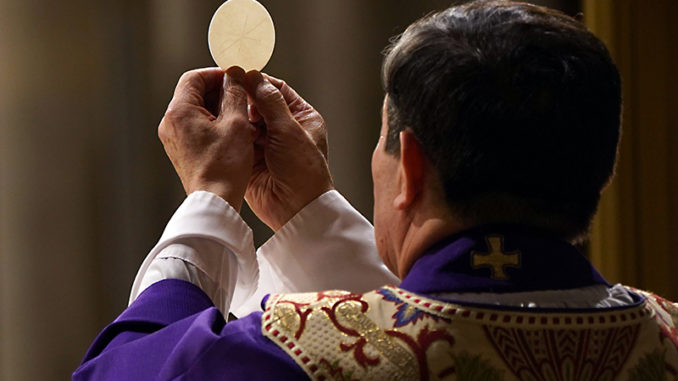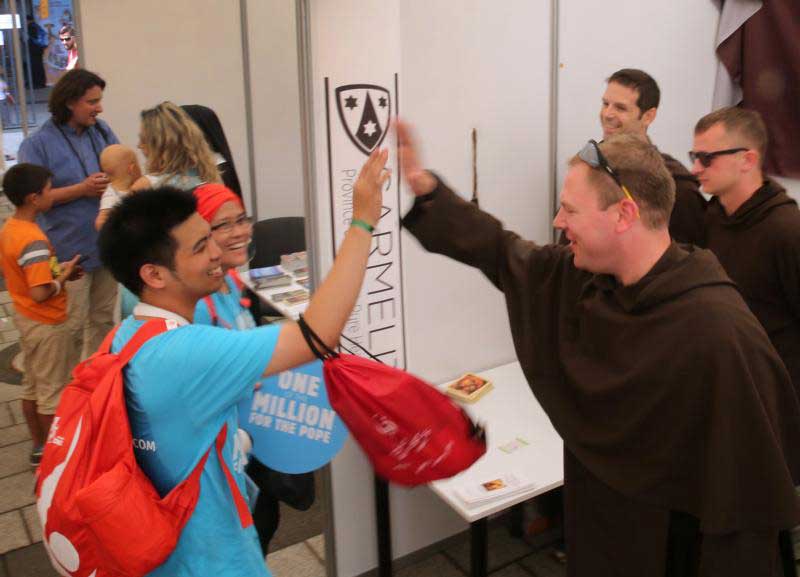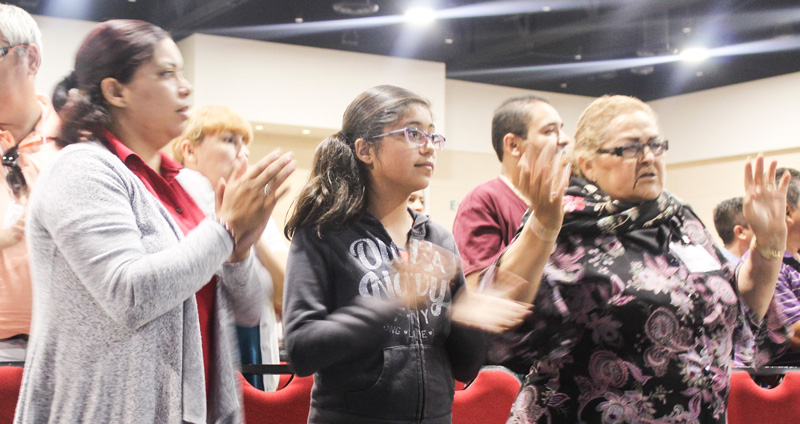
PHOENIX—Holy Week is a spiritual marathon of sorts, packed with liturgies, solemnity and tradition. This year, it also included a powerful document on the Eucharist issued by Phoenix Bishop Thomas J. Olmsted April 1, Holy Thursday.
Titled “Veneremur Cernui — Down in Adoration Falling,” it captured the attention of clergy and faithful alike in the days leading up to Easter.
Bishop Olmsted hopes the faith of practicing Catholics in the Eucharist will be deepened and fortified, propelling them into giving witness to others.
“The primary evangelizers we especially need now are laypeople who are so grateful for their faith,” Bishop Olmsted said.
The wonder and awe engendered by the Eucharist, he said, spurs these evangelizers who “just can’t help but tell somebody once in a while, ‘I can’t live without going to daily Mass, I couldn’t live without doing adoration.'”
“That’s what I’m especially hoping for: personal witness of the Eucharist,” Bishop Olmsted said.
Father John Muir, director of the diocesan Office of Worship and pastor of St. Thomas Aquinas Parish in Avondale, Arizona, echoed those thoughts.
Bishop Olmsted “is calling people who love their faith and are highly engaged to really see their own responsibility to reach out to people in their circle and say, ‘Hey, come with me to daily Mass, come with me to eucharistic adoration, come with me to Sunday Mass,'” Father Muir told The Catholic Sun, the online news outlet of the Diocese of Phoenix.
“It’s in the context of those friendships, I think, that people will discover the Eucharist,” he added.
The apostolic exhortation makes a number of requests of pastors, including that they hold eucharistic processions yearly. The Office of Worship is in the process of acquiring the various accouterments often used, such as the processional canopy. Parishes would be allowed to borrow these items.
“Not every parish has those kinds of things,” Father Muir said. Beyond that, the public nature of eucharistic processions holds a particular appeal.
“Everything’s been out of the public square because of COVID,” Father Muir said, pointing out that the many instances of political witness in the streets over the last year or so that have been violent and filled with bitterness and resentment.
“I love (the) bishop’s call for the church to be a joyful, confident, loving witness in the street,” he added. “Our faith isn’t meant to be just in the church. Our faith is meant to be in the world.”
Father Fernando Camou, who spent the last year living at Nazareth House, a seminary house of formation, but was recently appointed rector of Ss. Simon and Jude Cathedral, also shared his insights on “Veneremur Cernui.”
“One of the things that just jumped out to me is the sentence where he says, ‘Sunday is a day of protest against the idolatry of the world,'” Father Camou said. “Especially in our day when protests are kind of like the soup du jour. There’s something in every human heart that wants to stand up for something.”
Father Camou said his hope is people will not only read the apostolic exhortation, but that they’ll take time to study and ponder it as well, not getting overwhelmed by its length or the lesser-known aspects of theology it delineates.
“Veneremur Cernui” expounds on the scriptural, historical and theological truths of the Eucharist, but they are written about in a style that’s approachable to the average layperson who may not be able to articulate what the Catholic Church has always taught in that regard.
Father Paul Sullivan, director of vocations for the Diocese of Phoenix and pastor of Sacred Heart Parish in Phoenix, underlined the point.
Jesus, he said, is present to us in Scripture, in the community, but is “especially present and fully present in the Eucharist,” Father Sullivan said. If Jesus weren’t physically present in the Eucharist, he would only be present in a spiritual sense and “not present to us completely. And so in his infinite love he says, ‘I will not withhold any part of my presence.'”
Father Sullivan said he likes that the bishop’s document points to the importance of the Exodus story in the Old Testament and how Jesus is the new Passover, the fulfillment of the whole system of law, rituals and rites.
“Jesus is the fulfillment — the whole story points to him,” Father Sullivan said.
For men preparing for priesthood, the “Veneremur Cernui” is an invitation to renewed zeal for the Eucharist, Father Camou said.
Bishop Olmsted also addresses one’s worthiness to receive the Eucharist.
“By receiving the body of Christ in holy Communion, we manifest our union with the mystical body of Christ, the church,” he said in the document. “Therefore, if with our ‘Amen,’ we refuse to accept and live by the whole teaching of Christ and his church, we are not in communion with him but living a ‘fake’ union, one that overlooks truth and justice.”
Said Father Muir: “It’s the body of Christ given to strengthen the body of Christ so Christ’s body can fulfill its mission on earth. And that’s true for politicians, it’s true for firemen, it’s true for teachers, and it’s true for moms and dads and it’s true for all of us.”
By Joyce Coronel of the The Catholic Sun, the online new outlet of the Diocese of Phoenix.



